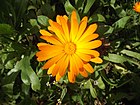Note: This is a project under development. The articles on this wiki are just being initiated and broadly incomplete. You can Help creating new pages.
Difference between revisions of "Calendula officinalis - Pot Marigold"
m (Arun93 moved page Calendula officinalis - Tagetes to Calendula officinalis - Pot Marigold: Wrong name) |
(→Chemical Composition) |
||
| (4 intermediate revisions by 2 users not shown) | |||
| Line 1: | Line 1: | ||
[[File:Calendula-arvensis-by-Zachi-Evenor-IZE11717 (1).jpg|thumb|right|Calendula(marigold)]] | [[File:Calendula-arvensis-by-Zachi-Evenor-IZE11717 (1).jpg|thumb|right|Calendula(marigold)]] | ||
| − | + | '''Calendula''' is a genus of about 15–20 species of annual and perennial herbaceous plants in the daisy family Asteraceae. They are native to southwestern Asia, western Europe, Macaronesia, and the Mediterranean. | |
| − | '''Calendula''' is a genus of about 15–20 species of annual and perennial herbaceous plants in the daisy family Asteraceae | ||
| − | |||
==Uses== | ==Uses== | ||
{{Uses|Fungal infections}}, {{Uses|Menopause}}, {{Uses|Menstrual cramps}}, {{Uses|Burns}}, {{Uses|Dermatitis}}, {{Uses|Eczema}}, {{Uses|Acne}}, {{Uses|Psoriasis}}, {{Uses|Ear infections}} | {{Uses|Fungal infections}}, {{Uses|Menopause}}, {{Uses|Menstrual cramps}}, {{Uses|Burns}}, {{Uses|Dermatitis}}, {{Uses|Eczema}}, {{Uses|Acne}}, {{Uses|Psoriasis}}, {{Uses|Ear infections}} | ||
| Line 11: | Line 9: | ||
==Chemical Composition== | ==Chemical Composition== | ||
| − | + | Faradiol-3-O-palmitate, faradiol-3-O-myristate, faradiol-3-O-laurate, arnidiol-3-O-palmitate, arnidiol-3-O-myristate, arnidiol-3-O-laurate<ref name="chemical composition"/> | |
==Common names== | ==Common names== | ||
| Line 37: | Line 35: | ||
==Identification== | ==Identification== | ||
===Leaf=== | ===Leaf=== | ||
| − | {{Leaf|Simple|Alternate| | + | {{Leaf|Simple|Alternate|Stalked–stalkless, lower stalks winged, upper leaves amplexicaul}}<ref name="Leaf"/> |
===Flower=== | ===Flower=== | ||
| − | {{Flower|Unisexual|4–7 cm (1.6–3 in.) wide| | + | {{Flower|Unisexual|4–7 cm (1.6–3 in.) wide|Brownish|5-20|Flowers Season is June–October}} |
===Fruit=== | ===Fruit=== | ||
| − | {{Fruit|Long-beaked|7–10 mm (0.28–0.4 in.) long pome| | + | {{Fruit|Long-beaked|7–10 mm (0.28–0.4 in.) long pome|Spine-backed achene|With hooked hairs|}} |
===Other features=== | ===Other features=== | ||
==List of Ayurvedic medicine in which the herb is used== | ==List of Ayurvedic medicine in which the herb is used== | ||
| − | |||
==Where to get the saplings== | ==Where to get the saplings== | ||
| Line 91: | Line 88: | ||
* [https://www.vithoulkas.com/learning-tools/books-gv/materia-medica-volume-7/calendula-officinalis Calendula officinalis on international academy of classical homeopathy ] | * [https://www.vithoulkas.com/learning-tools/books-gv/materia-medica-volume-7/calendula-officinalis Calendula officinalis on international academy of classical homeopathy ] | ||
[[Category:Herbs]] | [[Category:Herbs]] | ||
| + | [[Category:Asteraceae]] | ||
Latest revision as of 19:44, 14 September 2020
Calendula is a genus of about 15–20 species of annual and perennial herbaceous plants in the daisy family Asteraceae. They are native to southwestern Asia, western Europe, Macaronesia, and the Mediterranean.
Contents
- 1 Uses
- 2 Parts Used
- 3 Chemical Composition
- 4 Common names
- 5 Properties
- 6 Habit
- 7 Identification
- 8 List of Ayurvedic medicine in which the herb is used
- 9 Where to get the saplings
- 10 Mode of Propagation
- 11 How to plant/cultivate
- 12 Commonly seen growing in areas
- 13 Photo Gallery
- 14 References
- 15 External Links
Uses
Fungal infections, Menopause, Menstrual cramps, Burns, Dermatitis, Eczema, Acne, Psoriasis, Ear infections
Parts Used
Chemical Composition
Faradiol-3-O-palmitate, faradiol-3-O-myristate, faradiol-3-O-laurate, arnidiol-3-O-palmitate, arnidiol-3-O-myristate, arnidiol-3-O-laurate[1]
Common names
| Language | Common name |
|---|---|
| Kannada | |
| Hindi | Genda |
| Malayalam | |
| Tamil | |
| Telugu | |
| Marathi | NA |
| Gujarathi | NA |
| Punjabi | NA |
| Kashmiri | NA |
| Sanskrit | |
| English | Calendula, Pot Marigold |
Properties
Reference: Dravya - Substance, Rasa - Taste, Guna - Qualities, Veerya - Potency, Vipaka - Post-digesion effect, Karma - Pharmacological activity, Prabhava - Therepeutics.
Dravya
Rasa
Tikta (Bitter), Kashaya (Astringent)
Guna
Laghu (Light), Ruksha (Dry)
Veerya
Sheeta (Cold)
Vipaka
Katu (Pungent)
Karma
Kaphapitta shamaka
Prabhava
Habit
Identification
Leaf
| Kind | Shape | Feature |
|---|---|---|
| Simple | Alternate | Stalked–stalkless, lower stalks winged, upper leaves amplexicaul |
Flower
| Type | Size | Color and composition | Stamen | More information |
|---|---|---|---|---|
| Unisexual | 4–7 cm (1.6–3 in.) wide | Brownish | 5-20 | Flowers Season is June–October |
Fruit
| Type | Size | Mass | Appearance | Seeds | More information |
|---|---|---|---|---|---|
| Long-beaked | 7–10 mm (0.28–0.4 in.) long pome | Spine-backed achene | With hooked hairs | {{{6}}} |
Other features
List of Ayurvedic medicine in which the herb is used
Where to get the saplings
Mode of Propagation
How to plant/cultivate
Calendula officinalis is easy to grow and seeds can be sown in the late spring and early summer months.[3]
Commonly seen growing in areas
Temperate regions, Mediterranean countries, North America and Asia.
Photo Gallery
References
External Links
- Ayurvedic Herbs known to be helpful to treat Fungal infections
- Ayurvedic Herbs known to be helpful to treat Menopause
- Ayurvedic Herbs known to be helpful to treat Menstrual cramps
- Ayurvedic Herbs known to be helpful to treat Burns
- Ayurvedic Herbs known to be helpful to treat Dermatitis
- Ayurvedic Herbs known to be helpful to treat Eczema
- Ayurvedic Herbs known to be helpful to treat Acne
- Ayurvedic Herbs known to be helpful to treat Psoriasis
- Ayurvedic Herbs known to be helpful to treat Ear infections
- Herbs with Petals used in medicine
- Herbs with Flowers used in medicine
- Herbs with Leaves used in medicine
- Herbs with common name in Hindi
- Herbs with common name in English
- Habit - Herb
- Index of Plants which can be propagated by Seeds
- Herbs that are commonly seen in the region of Temperate regions
- Herbs that are commonly seen in the region of Mediterranean countries
- Herbs that are commonly seen in the region of North America and Asia
- Herbs
- Asteraceae










